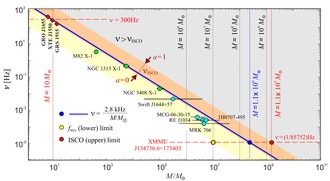Fourier analysis of the X-ray light curves from accreting Galactic compact sources reveals regular patterns buried in the noise. For Galactic black hole sources, these quasi-periodic oscillations (QPOs) have frequencies ~100 Hz, corresponding to orbital Keplerian frequencies a few gravitational radii away from a stellar-mass black hole. They are stable over very long periods of time. For example, QPOs of 300 Hz and 450 Hz were observed from the microquasar GRO J1655–40 during its 1996 outburst and again almost nine years later during its 2005 outburst. This strongly suggests that the frequencies cannot depend on quantities such as magnetic field, density, temperature, or accretion rate, as these all vary greatly in time. The only parameters of a black hole accretion system that do not vary over a nine year period are the mass and the spin of the central black hole. Thus, the QPO frequencies must only depend on mass and spin. Furthermore, the QPO frequencies are inversly proportional to the black hole mass. Often, the QPOs appear as a double peak in the Fourier spectra, and their two frequencies are in some rational ratios, most often 3:2. This suggests a resonance. Several resonances between different oscillatory modes of accretion disks have been suggested: Keplerian, epicyclic, Lense-Thirring, and their combinations. The double peak QPOs have been found also in the super-massive black holes in other galaxies. By making assumptions of which resonance is there in operation, one may derive from the observed frequency the mass and the spin of the black hole. The paper "Mass of the active galactic nucleus black hole XMMUJ134736.6+173403", Kateřina Goluchová, Gabriel Török, Eva Šrámková, Marek A. Abramowicz (from CAMK PAN in Warsaw), Zdeněk Stuchlík, Jiří Horákby makes such estimates for the X-ray AGN source XMMUJ134736.6+173403. Methods used are standard, but conclusions are not: the authors claim that "XMMUJ134736.6+173403 is the most massive BH source with commensurable QPO frequencies ever discovered".
Picture: Black hole QPOs for different BH sources (see the paper for detailed explanations).
Text: M.A. Abramowicz







